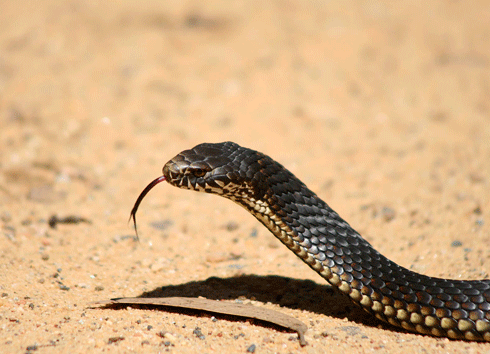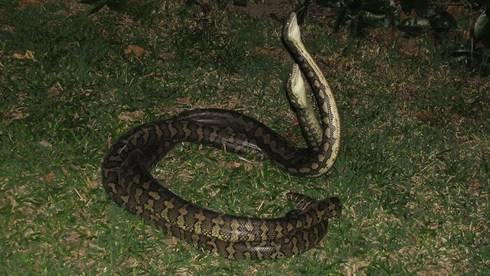
|
Published: 4 March 2013
Some snakes are lovers, others are fighters
When it comes to the choice between making love or war, size really does matter – if you are a snake, that is. Renowned Sydney University biologist, Professor Rick Shine, heralds our entrance into the Chinese Year of the Snake by sharing some unusual insights into the sometimes combative, sometimes sensual world of these much-maligned reptiles.

|
|
Professor Rick Shine with friendly water python – 2013 is also the Tibetan Year of the Water Snake. Credit:
Terri Shine
|
As a snake biologist, the Chinese Year of the Snake has special resonance for me and for many of my colleagues – based on the amount of celebratory email messages that have flooded my inbox to mark the prominent role of our favourite animals in 2013. So I am led to ponder: what it is about snakes that led Chinese culture to allot them a special status as one of the 12 animal symbols in their zodiac?
One clue to the snake’s status comes from the supposed attributes of people born in the Year of the Snake. The websites I consulted on this topic were contradictory – one site said that such people were ‘gregarious, introverted, generous and dangerous’, a somewhat bewildering combination!
However, most websites agreed on one trait: that snake-sign people are slightly oversexed. And, having spent most of career investigating the sex lives of serpents around the world, I can readily see a basis for that link.
Until quite recently, we knew very little about snake reproductive behavior. What we did know generally came from anecdotal observations, mostly involving a couple of snakes intertwined as they slithered across the grass.
Indeed, the sight of two large red-bellied black snakes engaged in frenetic wrestling matches is one of the great spectacles of the Australian bush in springtime. The bright red bellies of the snakes – hidden during their normal activities – stand out dramatically as the snakes raise their heads well above the ground, intertwining their bodies as they sway and topple back to the ground.
Often misinterpreted as a courtship display, or as actual mating, these spectacular ‘dances’ are actually ritualised combat bouts between rival males. Although rarely reported – probably because snakes are so secretive – we now know that combat behavior occurs in the males of many Australian snakes.
Just like black snakes, male tiger snakes and copperheads engage in prolonged battles. So do the males of many smaller elapid (venomous) snakes, such as small-eyed snakes and whipsnakes.

|
|
Copperheads are among Australia’s venomous snakes – in many species, the males engage in prolonged ritualised battles. Credit:
Sylvain Dubey
|
More dramatically, males of some of the largest python species also engage in titanic battles. In tropical Queensland, males of two of Australia’s largest snake species – scrub pythons (to at least four metres long) and carpet pythons (to at least three metres) – fight their rivals for access to reproductive females.
The formidable constricting power of these giant snakes, and their willingness to bite as well as wrestle – unlike most of the venomous snakes – makes for an unforgettable knockdown, dragged out fight. It’s especially impressive when these battles happen inside the ceiling space of your house. Pythons love such places, which provide shelter, as well as access to tasty rats and possums. The crashing and bashing of a python fight above the home-owners’ heads can sound like a miniature Armageddon.
Unlike the combative species, the males of many other snake species pursue very different tactics: focusing on making love, not war. They tolerate their rivals, and devote their efforts to courtship rather than all-out warfare.
Males typically do not grow as large as females in these more amorous species, presumably because larger body size doesn’t impress the girls – even though it helps a lot in defeating a rival male in a combat bout.
Remarkably, we can see this correlation between sexual size dimorphism (i.e. males bigger or smaller than females) and mating systems (males fight each other, or they don’t) even within separate populations of wide-ranging species.
The most spectacular example is the carpet python. While these large snakes are found over most of the Australian mainland, in different areas they form fairly recognisable colour varieties (usually allocated to different subspecies).
As already noted, the monster carpet pythons of tropical Queensland engage in ferocious battles between males. But their southern cousins — the elegant diamond pythons of the Sydney region — ignore other males, instead spending the mating season in aggregations around a receptive female.
Although snake courtship itself is a fairly restrained and gentle affair, finding five or six giant pythons nestled together inside your ceiling space may be almost as worrying for a home owner as having two aggro male snakes beating each other up in the same area. But, at least in the case of the diamond pythons, the boys are smaller than the girls – so there is not quite as much snake biomass to face when you poke your head through the manhole cover to investigate the noise!
We know a lot less about the sex lives of Chinese snakes than of Australian species. It’s probably fair to say that in China, snakes have been more important as cultural and culinary items than as research subjects, at least until recently.
It’s a reasonable bet, though, that oriental serpents get up to many of the same shenanigans as their counterparts from downunder, and it was observations of these red-blooded battles and passionate dalliances that probably stimulated early Chinese scholars to include the snake among their animal zodiac.
Prof Rick Shine is Professor in Evolutionary Biology at The University of Sydney’s School of Biological Sciences.




